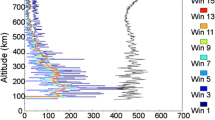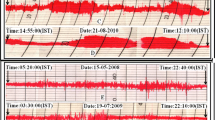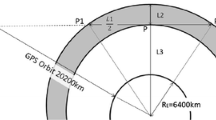Abstract
The three-dimensional global morphology and seasonal characteristics of the ionospheric scintillation index of the F-layer between 150 and 550 km altitudes are analyzed using the GPS radio occultation measurements from the Constellation Observing System for Meteorology, Ionosphere and Climate during the 7-year period of low and high sunspot activity from 2007 to 2013. The results show that the prominent scintillation intensity, which is confined within ±30° geomagnetic latitude, starts at post-sunset, reaches a maximum at around pre-midnight, and often persists until postmidnight. Moderate scintillation activity can be observed in the high-latitude region almost at any time, whereas weak scintillation prevails in the midlatitude region. The noticeable scintillation peak near midnight occurs at an altitude of approximately 250 km in most cases. However, the peak of the scintillation activity during the solar maximum extends to higher altitudes than observed during the solar minimum. Additionally, the local variation in time and altitude of the scintillation intensity is closely correlated with ionospheric HmF2. Statistical analysis indicates that an increase in solar activity or geomagnetic activity enhances the occurrence rate of scintillation and results in intense scintillation. The current research is beneficial for directly studying global ionospheric irregularities at GHz frequency based on high-rate L1 data and constructing a global scintillation model.







Similar content being viewed by others
References
Aarons J (1982) Global morphology of ionospheric scintillations. Proc IEEE 70(4):360–378. doi:10.1109/PROC.12314
Abdu MA, Iyer KN, de Medeiros RT, Batista IS, Sobral JH (2006) Thermospheric meridional wind control of equatorial spread F and evening prereversal electric field. Geophys Res Lett. doi:10.1029/2005GL024835
Abdu MA, Batista IS, Reinisch BW, De Souza JR, Sobral JHA, Pedersen TR, Medeiros AF, Schuch NJ, de Paula ER, Groves KM (2009) Conjugate Point Equatorial Experiment (COPEX) campaign in Brazil: electrodynamics highlights on spread F development conditions and day-to-day variability. J Geophys Res Space Phys. doi:10.1029/2008JA013749
Alfonsi L, Spogli L, De Franceschi G, Romano V, Aquino M, Dodson A, Mitchell CN (2011) Bipolar climatology of GPS ionospheric scintillation at solar minimum. Radio sci. doi:10.1029/2010RS004571
Brahmanandam PS, Uma G, Liu JY, Chu YH, Latha Devi NSMP, Kakinami Y (2012) Global S4 index variations observed using FORMOSAT-3/COSMIC GPS RO technique during a solar minimum year. J Geophys Res 117:A09322. doi:10.1029/2012JA017966
Dymond KF (2012) Global observations of L band scintillation at solar minimum made by COSMIC. Radio Sci. doi:10.1029/2011RS004931
Fejer BG (1996) Natural ionospheric plasma waves. In: Kohl H, Ruster R, Schelegel K (eds) Modern ionospheric science. Max-Planck Institute For Aeronomy, Lindau, pp 217–273
Fejer BG, Scherliess L, de Paula ER (1999) Effects of the vertical plasma drift velocity on the generation and evolution of equatorial spread F. J Geophys Res 104(A9):19859–19869
Fong CJ, Shiau WT, Lin CT, Kuo TC, Chu CH, Yang SK, Yen N, Chen SS, Kuo YH, Liou YA, Chi S (2008) Constellation deployment for FORMOSAT-3/COSMIC mission. IEEE Trans Geosci Remote Sensing 46(11):3367–3379. doi:10.1109/TGRS.2008.2005202
Garcia D (2010) Robust smoothing of gridded data in one and higher dimensions with missing values. Comput Stat Data Anal 54(4):1167–1178
Huang Z, Yuan H (2015) Climatology of the ionospheric slab thickness along the longitude of 120 E in China and its adjacent region during the solar minimum years of 2007–2009. Ann Geophys 33:1311–1319
Kelley MC (1989) The Earth’s ionosphere: plasma physics and electrodynamics. International Geophysics Series, 43. Academic Press, San Diego
Kelley MC, Maruyama T (1992) A diagnostic method for equatorial spread F 2. The effect of magnetic activity. J Geophys Res 97(A2):1271–1277
Keskinen MJ, Ossakow SL (1983) Theories of high-latitude ionospheric irregularities: a review. Radio sci 18(6):1077–1091
Ko CP, Yeh HC (2010) COSMIC/FORMOSAT-3 observations of equatorial F region irregularities in the SAA longitude sector. J Geophys Res 115:A11309. doi:10.1029/2010JA015618
Krishnamurthy BV, Rao BR (1963) Time of onset of spread-F in relation to post sunset h’F variations. J Atmos Terr Phys 25(4):209–210
Li G, Ning B, Yuan H (2007) Analysis of ionospheric scintillation spectra and TEC in the Chinese low latitude region. Earth Planets Space 59(4):279–285
Li G, Ning B, Abdu MA, Wan W, Hu L (2012) Precursor signatures and evolution of post-sunset equatorial spread-F observed over Sanya. J Geophys Res Space Phys. doi:10.1029/2012JA017820
Liou YA, Pavelyev AG, Liu SF, Pavelyev AA, Yen N, Huang CY, Fong CJ (2007) FORMOSAT-3 GPS radio occultation mission: preliminary results. IEEE Trans Geosci Remote Sensing 45(10):3813–3826. doi:10.1109/TGRS.2007.903365
Luo WH, Xu JS, Zhu ZP (2013) Theoretical modeling of the occurrence of equatorial and low-latitude ionospheric irregularity and scintillation. Chin J Geophys 56(9):2892–2905. doi:10.6038/cjg20130903
Lyon AJ, Skinner NJ, Wright RW (1960) Equatorial spread-F and F-layer heights. Nature 187(9):1086–1088
Maruyama T (1988) A diagnostic model for equatorial spread F, 1, Model description and application to electric field and neutral wind effects. J Geophys Res Space Phys 93(A12):14611–14622
Maruyama N, Richmond AD, Fuller-Rowell TJ, Codrescu MV, Sazykin S, Toffoletto FR, Spiro RW, Millward GH (2005) Interaction between direct penetration and disturbance dynamo electric fields in the storm-time equatorial ionosphere. Geophys Res Lett. doi:10.1029/2005GL023763
Muella MTAH, de Paula ER, Kantor IJ, Batista IS, Sobral JHA, Abdu MA, Kintner PM, Groves KM, Smorigo PF (2008) GPS L-band scintillations and ionospheric irregularity zonal drifts inferred at equatorial and low-latitude regions. J Atmos Sol Terr Phys 70(10):1261–1272
Ngwira CM, McKinnell LA, Cilliers PJ (2010) GPS phase scintillation observed over a high-latitude Antarctic station during solar minimum. J Atmos Sol Terr Phys 72(9):718–725
Otsuka Y, Shiokawa K, Ogawa T (2006) Equatorial ionospheric scintillations and zonal irregularity drifts observed with closely spaced GPS receivers in Indonesia. J Meteorol Soc Jpn 84A:343–351. doi:10.215/jmsj.84A.343
Pavelyev AG, Liou YA, Wickert J, Schmidt T, Pavelyev AA, Liu SF (2007) Effects of the ionosphere and solar activity on radio occultation signals: application to Challenging Minisatellite Payload satellite observations. J Geophys Res 112(A6):A06326. doi:10.1029/2006JA011625
Pi X, Mannucci AJ, Lindqwister UJ, Ho CM (1997) Monitoring of global ionospheric irregularities using the worldwide GPS network. Geophys Res Lett 24(18):2283–2286
Rao PVSR, Krishna SG, Niranjan K, Prasad DSVVD (2006) Study of spatial and temporal characteristics of L-band scintillations over the Indian low-latitude region and their possible effects on GPS navigation. Ann Geophys 24(6):1567–1580
Scherliess L, Fejer BG (1999) Radar and satellite global equatorial F-region vertical drift model. J Geophys Res 104:6829
Schreiner W, Rocken C, Sokolovskiy S, Syndergaard S, Hunt D (2007) Estimates of the precision of GPS radio occultations from the COSMIC/FORMOSAT-3 mission. Geophys Res Lett 34:L04808
Uma G, Liu JY, Chen SP, Sun YY, Brahmanandam PS, Lin CH (2012) A comparison of the equatorial spread-F derived by International Reference Ionosphere and the S4 index observed by FORMOSAT-3/COSMIC during the solar minimum period of 2007–2009. Earth Planets Space 64:467–471
Acknowledgements
COSMIC S4 index data were provided by the Taiwan Analysis Center for COSMIC (TACC)/COSMIC Data Analysis and Archive Center (CDAAC). This research was supported by the National Natural Science Foundation of the Republic of China (41104096).
Author information
Authors and Affiliations
Corresponding author
Rights and permissions
About this article
Cite this article
Chen, S., Huang, Z. Ionospheric F-layer global scintillation index variation using COSMIC during the period of 2007–2013. GPS Solut 21, 1049–1058 (2017). https://doi.org/10.1007/s10291-016-0593-2
Received:
Accepted:
Published:
Issue Date:
DOI: https://doi.org/10.1007/s10291-016-0593-2




